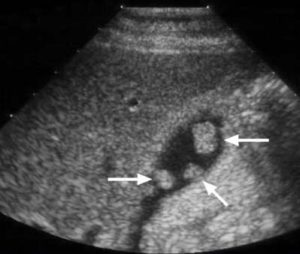
Picture source: Bel Mara Health
Gallbladder polyps are growths that protrude from the lining inside the gallbladder. They are incidental detections in approximately 4%–7% of patients who undergo ultrasound scan of the abdomen. The overwhelming majority of these lesions are benign (non-cancerous) and represent cholesterol or inflammatory polyps. Many lesions labelled as gallbladder polyps following a scan prove to be small stones upon cholecystectomy (removal of the gall bladder). About 95% of gallbladder polyps are benign.
Patients with gallbladder polyps typically do not experience any symptoms. Rarely, the polyp may block the Hartmann’s pouch or cystic duct and cause cholecystitis (inflammation of the gallbladder). Similarly, if it blocks the main bile duct it may result in obstructive jaundice or pancreatitis. Gallbladder polyps have also been associated with chronic dyspeptic abdominal pain.
 Both patient and doctor have cause for concern if the polyp is malignant. First, let us understand more about gallbladder cancer. Gallbladder cancers are rare and nearly all of them are adenocarcinomas. Gallbladder cancer is usually asymptomatic until later in the course of the disease, when the tumor is large and/or has spread. Risk factors for gallbladder cancer are female gender, obesity, smoking, gallstones, porcelain gallbladder, and choledochal cyst. The overall prognosis for gallbladder cancer is poor, with a 5-year survival rate of approximately 10%. Therefore, the threshold of management of gallbladder polyps is difficult.
Both patient and doctor have cause for concern if the polyp is malignant. First, let us understand more about gallbladder cancer. Gallbladder cancers are rare and nearly all of them are adenocarcinomas. Gallbladder cancer is usually asymptomatic until later in the course of the disease, when the tumor is large and/or has spread. Risk factors for gallbladder cancer are female gender, obesity, smoking, gallstones, porcelain gallbladder, and choledochal cyst. The overall prognosis for gallbladder cancer is poor, with a 5-year survival rate of approximately 10%. Therefore, the threshold of management of gallbladder polyps is difficult.
Thankfully, most gallbladder polyps do not turn malignant (cancerous). Corwin highlighted the low likelihood of gallbladder cancer in small polyps in a long term clinical and ultrasound analysis of 346 patients.
The size of a gallbladder polyp can help predict whether it is malignant or benign. Small gallbladder polyps that are less than 10mm in diameter are unlikely to be cancerous. Gallbladder polyps larger than 10mm in diameter are more likely to be cancerous or turn malignant over time. The incidence of cancer has been said to be as high as 100% in polyps larger than 20mm. CT scan and oesophageal ultrasound scan can provide the information needed to further manage a patient with gallbladder polyps.
Current recommendations regarding the management of gallbladder polyps suggest cholecystectomyfor lesions with a diameter of 10mm or greater and ultrasound follow-up for lesions smaller than 10mm. Patients with gallstones or primary sclerosing cholangitis should be considered for surgery irrespective of size of the gallbladder polyps because of the high incidence of malignant transformation of polyps associated with these conditions. However, the interval of follow-up and overall duration of follow-up remains controversial.
References
- Corwin, MT, Siewert, B, Sheiman, RG, Kane, RA. Incidentally detected gallbladder polyps: is follow-up necessary? Long-term clinical and US analysis of 346 patients. Radiology 2011.258: 277.
- Zakko WF, Zakko SF. Gallbladder polyps and cholesterolosis. UpToDate Web site. http://www.uptodate.com/. Published September 30, 2009.
[This article belongs to The Malaysian Medical Gazette. Any republication (online or offline) without written permission from The Malaysian Medical Gazette is prohibited.]
